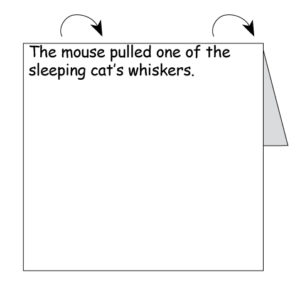Writing collectively: taking turns, continued, chain or folded stories
Procedure:
The basic pattern is as follows:
a) The students receive a sentence or a small paragraph as part of the beginning of a story, or they write such a beginning at the top of the page themselves.
b) They then pass on the piece of paper to the person on their right who reads what has been written, adds 1 or 2 sentences to continue the story, and passes it on to the next person on the right.
c) The exercise is done when all sheets of paper have circulated through the class or group once.
d) Finally, the stories are read out loud and/or hung up in the classroom.
Remarks:
- Toward the end of a sequence (when the papers have circulated through most of the class), it would be useful to advise the students that the last two or three sentences should draw the story to a conclusion, such that it does not simply end abruptly.
- With younger children, it is helpful to first create stories orally (see above #1: preliminary exercise).
- Corrections should be made carefully, so as not to diminish students‘ creativity. However, the teacher should certainly review the texts, as they may well evidence areas in need of support where many students may still make mistakes.
Variants:
- Instead of engaging the whole class in this exercise, it can be conducted with just one or two group levels, as long as the activity was well introduced.
- Another option would be groups of 3–4 children with each group writing a chain story. In this case, the sheets would circulate more than once through the group.
- It would also be possible to circulate just one sheet of paper. This way, a story is being created parallel to the normal lesson, which is then read out at the end of the lesson.
- Folded story: In lieu of reading what has been written before passing the paper on to the next person, it should be folded in a way that allows for reading the last sentence only, but not the previous ones. The resultant text makes the ultimate reading of the entire story more exciting and surprising.

- Word by word: this variation is for smaller groups with younger students. Instead of working sentence by sentence (1–2 sentences), it is possible to proceed word by word: Start with long paper strips (A3 size, cut horizontally into 4–5 strips). One word each is written on the paper, to be used as the beginning of the sentences. Each student then adds one word (or at most 3 words) and passes the strip on to the next person who does the same. At the end there are several paper strips with sentences.






